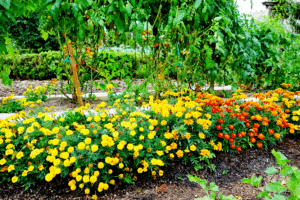Companion planting is an age-old ecological practice that allows you to improve the growth of your vegetables and fight against pests naturally, without using chemical pesticides. By understanding beneficial plant associations, this technique enables you to maximize the available space in your garden and achieve better results during harvest time.
We will explore how integrating certain plants with your tomatoes can boost their growth and yield.
Contenus de la page
The art of companion planting for tomatoes
To get started with companion planting, it’s essential to know which plants work best together and which should be avoided near your tomatoes. Not only do compatible plants help each other grow and develop by repelling parasites and attracting beneficial insects, they also improve the soil structure.
Here, we’ll discuss some of the most effective plant combinations and strategies for a thriving tomato garden.
- Carrots: Pairing tomatoes with carrots helps aerate the soil surrounding the tomato roots, enabling better access to oxygen. This association makes efficient use of space since carrots grow rapidly, preventing weeds from invading areas cleared by tomato plants.
- Onions and garlic: To naturally combat pests that prey on your tomatoes, consider planting onions and garlic nearby. Their odor works as a deterrent for several unwanted critters.
Plants to avoid when growing tomatoes
While there are plenty of great plant partnerships for tomatoes, there are also some species that should be kept away from the beloved fruit-bearing plants. Keeping these specific types at a distance minimizes competition for resources and creates a more harmonious environment for your garden.
Make sure there is enough space between plants to promote healthy growth and avoid competition for resources.
Companion planting doesn’t just involve vegetables. Planting flowers and herbs between your crops contributes to a diverse and balanced ecosystem, further promoting the health of your plants overall.
The secret weapon for your tomato garden
One of the most potent plants you can integrate into your tomato garden is the charming marigold.
These vibrant flowers release compounds that repel various pests such as nematodes and aphids, preserving the health of your tomato plants. Plus, marigolds act as magnets for pollinating insects, encouraging better fertilization and more abundant fruit production.
Here’s why you should consider adding marigolds to your tomato plot:
- Natural pest protection: By emitting substances that deter harmful pests, marigolds make it more difficult for unwelcome critters to infiltrate and damage your tomatoes.
- Attracting pollinators: Marigolds lure beneficial insects like bees and butterflies, which play a vital role in fertilizing tomato flowers. This results in higher quality fruits and an overall larger harvest.
Planting marigolds next to your tomatoes promises to amplify your summer harvest.
Creating a healthy ecosystem through companion planting
An essential aspect of companion planting lies in creating a healthy and diverse space for all species within your garden. Implementing variety within your crop beds creates an environment where plants can support one another, ensure their growth, and mitigate the presence of harmful pests.
To develop a thriving ecosystem, plant different types of fruits, vegetables, flowers, and herbs together – this not only benefits each plant but makes for a beautiful and productive garden overall.
Start your own companion planting adventure
With the combination of expertise and experimentation, you can establish a flourishing companion planting strategy in your own garden.
Start by implementing some of these tried-and-true plant associations for your tomatoes to see how marigolds, carrots, onions, and garlic enhance growth and increase yield.
As you master these techniques, you may find yourself inspired to extend companion planting to other areas of your garden.
In conclusion, embracing the practice of companion planting allows you to optimize the space available in your garden, naturally protect your vegetables from pests, and achieve better results at harvest time – just remember to use our recommended plants, follow spacing guidelines and watch your tomato garden thrive!


